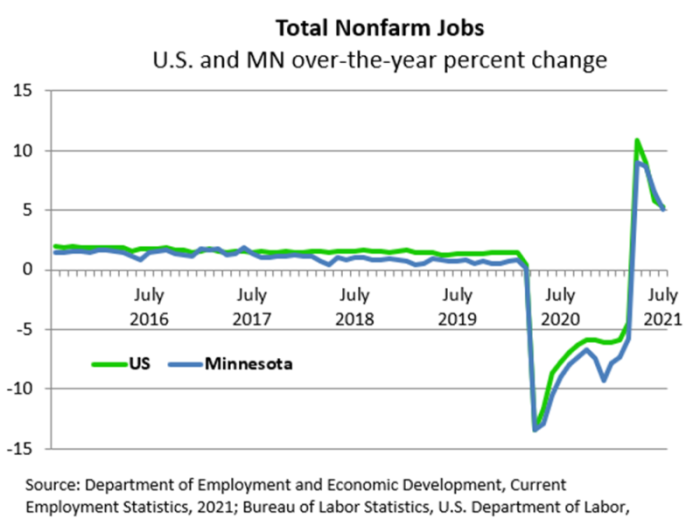by Nick Dobbins
August 2021
The Minneapolis-St. Paul-Bloomington MSA lost 2,790 jobs or 0.1% on an unadjusted basis in July. This was slightly better than the statewide decline of 0.3%. The declines came despite positive over-the-month growth in seven of 10 published supersectors. Losses were largely driven by Government employment, which was off by 13,351 jobs (5.6%), primarily among Local Government Educational Services (down 14,286 or 16.6%). Declines like this in Government employment are common in July as schools often carry far fewer employees over the summer months. The only other supersectors to lose jobs were Trade, Transportation, and Utilities (down 0.4%) and Education and Health Services (down 0.8%). Positive monthly growth, both real and proportional, was largest in Leisure and Hospitality (up 7,606 jobs or 4.6%).
Over the year the metro area added 87,807 jobs or 4.7%, which was lower than June's 6% increase. This declining over-the-year growth from month-to-month is in line with larger state and national trends, as the labor market's recovery from the shock of early 2020 begins to level off. The largest over-the-year growth, both real and proportional, continued to come in Leisure and Hospitality (up 32,144 jobs or 23.1%). Otherwise, growth in all supersectors continued to come in between 2.9% and 8% with two exceptions that posted negative growth. Information employment was off 4.6% (1,479 jobs), and Financial Activities employment was down 0.9% (1,387 jobs).
The Duluth-Superior MSA lost 272 jobs or 0.2% over the month in July, slightly better than the state's 0.3% loss. The decline was driven by Government employment, off 972 (3.8%), with notable losses also coming in Trade, Transportation, and Utilities, which was down 414 jobs (1.7%) primarily from the loss of 412 jobs (2.8%) in Retail Trade. Leisure and Hospitality added 832 jobs or 5.9%, the largest real and proportional growth of any supersector. Six of 10 published supersectors added jobs on the month.
Annual growth in the Duluth area was at 7.7% or 9,399 jobs. This was the best proportional over-the-year growth of any MSA in Minnesota. Every published supersector added jobs on the year, led by Leisure and Hospitality (up 2,481 or 20%), Government (up 2,874, 13.4%), Educational and Health Services (up 1,662 or 5.6%), and Mining, Logging, and Construction (up 927 or 10.5%). Only one supersector, Financial Activities, posted growth of less than 1% (0.6% or 32 jobs).
The Rochester MSA added 52 jobs (0%) over the month in July. This was the best performance of any MSA in Minnesota and the only area to not lose jobs on the month. Losses in Government (down 407 jobs or 3.1%) and Trade, Transportation, and Utilities (down 179 or 1%), were offset by gains in all but one other supersector – Other Services lost 4 jobs. The biggest positive growth by far came in Leisure and Hospitality, which was up by 517 jobs or 4.9%. Mining, Logging, and Construction added 133 jobs (2.4%).
Over the year the Rochester area added 5,803 jobs (4.9%). Leisure and Hospitality had the largest proportional growth, up 14.2% (1,362 jobs), while the largest actual job growth came in the region's vital Educational and Health Services supersector, which added 3,022 jobs (6%). Manufacturing posted the largest losses in the area, off by 536 jobs or 5.1%.
The St. Could MSA lost 490 jobs (0.5%) over the month in July. The losses were driven by a decline of 7.3% (1,082 jobs) in Government employment, which was common across the state as school staffs decreased for the summer. The next-largest decline came in Mining, Logging, and Construction, which was off by 27 jobs or 0.3%. The largest positive growth came in Leisure and Hospitality (up 188 or 2.8%) and Manufacturing (up 242 or 1.7%).
Over the year the area added 4,379 jobs or 4.3%. This was the worst over-the-year job growth of any MSA primarily in Minnesota although Grand Forks-East Grand Forks, which is primarily in North Dakota, was up only 3.3%. Manufacturing added 1,140 jobs (8.4%), and Government added 962 jobs (7.5%). Leisure and Hospitality, which was driving positive growth elsewhere in the state, lost 59 jobs (0.9%) on the year in the St. Cloud area. For comparison, employment in the supersector was up by 24% over the year across the state.
The Mankato-North Mankato MSA lost 840 jobs (1.5%) in July. It was the worst over-the-month performance of any MSA primarily in Minnesota although Grand Forks-East Grand Forks, which is primarily in North Dakota, lost 3%. Government employers lost 1,091 jobs (10.8%) while private sector employers added just 251 jobs (0.5%).
Over the year the Mankato-North Mankato area added 3,463 jobs or 6.7%, outpacing the statewide growth of 5.1%. Service providers added 3,227 jobs (7.7%), and goods producers added 236 (2.5%).
The Fargo-Moorhead MSA lost 1,914 jobs (1.3%) over the month in July. Losses were driven by Government employment, which was down 2,805 (15.6%) thanks to a loss of 2,091 jobs (20.3%) at the Local Government level. The largest real and proportional gains in the MSA came in Professional and Business Services, which was up 416 or 3%.
Over the year the Fargo-Moorhead MSA added 7,574 jobs (5.6%). Leisure and Hospitality drove the growth, up 2,732 jobs or 23.7%. Information was the only supersector to lose jobs on the year (down 66 or 2.2%).
The Grand Forks-East Grand Forks MSA lost 1,527 jobs (3%) over the month in July. Declines were driven by Government employment, which was off by 1,876 or 15.2%. The best performance came in Manufacturing, which was up by 151 or 4.2%.
The Grand Forks-East Grand Forks MSA also had the worst over-the-year performance in the state, adding just 1,597 jobs or 3.3%. Leisure and Hospitality drove the growth, adding 1,001 jobs (20.8%). Four supersectors in the area lost jobs on the year led by Professional and Business Services, which was down 265 or 7.6%.
